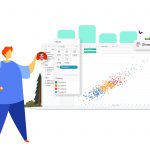Tableau is a data visualization platform that offers collaborative data visualization software for organizations and just about anyone that works with business information analytics. It’s able to extract data from text documents, PDFs, and even cloud databases.
This visual analytics platform has transformed how people tackle issues surrounding their data. Tableau developers can be helpful when using the platform, but it’s built to enable anyone looking to start reporting and analyzing vast volumes of data.
Maybe you’re asking yourself, ”Why use Tableau?” Since it became public, Tableau has blown up in terms of popularity. Today, we will be jumping into everything you need to know about creating a Dashboard in Tableau.
1. Creating Sheets
For you to have a Dashboard, you will first need to have at least one sheet created. The main idea behind a Dashboard is to provide you with interactivity between sheets, so make sure you have multiple sheets before moving forward with this guide.
To create a sheet, navigate to the ‘My Worksheet’ menu in the Data Source Section, then click on ‘New Worksheet.’ Alternatively, you can right-click on any open tab in the workbook, then select ‘New Worksheet’ from the menu. A drop-down arrow on the toolbar will enable you to create a worksheet by clicking on the button. You can also press ‘Control + M’ on Windows or ‘Command + M’ on a Mac to create a sheet using the shortcut.
2. Creating the Dashboard
At the bottom of any one of your workbooks, click on the ‘New Dashboard’ icon. Then, from the Sheets list on the left side, you will be able to drag views to your Dashboard on the right.
If you are aiming to replace a sheet, you need to select it on the Dashboard and hover over the replacement sheet, after which you can click the ‘Swap Sheets’ button. At the point in time when you end up replacing any sheet, Tableau will still maintain any padding border or background color that the previous sheet was set to. Keep in mind that you will still need to adjust the sheet size if the content within it is different.
3. The Dashboard Pane
You will now notice on the left side of your screen a lot of tabs as well as options that relate directly to the Dashboard itself. Here, you will find a Dashboard pane that will showcase its size and the list of available sheets within a workbook.
Then, you can enter custom dimensions, such as the height and width of the Dashboard, depending on your requirements. There’s also a list of available fixed dashboard sizes that you can select.
4. The Layout Pane
Next to the Dashboard pane, you will find the Layout pane where you can change the appearance of the layout of the Dashboard. This is done through the procedure of setting up the position, size, border, background, and paddings.
5. Adding a Sheet to the Dashboard
At this point in time, you are free to add any sheet to the empty Dashboard. The way to do this is simple. Drag and drop a sheet from the ‘Sheets’ column, which is available to you in the Dashboard tab. This will display all of the visualizations set on that sheet in the Dashboard; these can be changed by heading over to ‘Graph’ and selecting the downward-pointing arrow.
6. Adding Multiple Sheets
Another feature of the Dashboard is that you can add as many sheets as you need while arranging them on the Dashboard as you see fit.
If you want to add a filter to a dashboard within Tableau, you can select the ‘Use as Filter’ option on the right side of each visual. You can make the Dashboard a lot more interactive and dynamic by adding Objects, such as a web page, button, text box, or any extension you might require. All of this can then be viewed in the ‘Presentation Mode,’ where you must click the icon on the top bar or press F7 on your keyboard.
Moving Forward with Tableau
Now, you know everything there is to know about the creation of a Dashboard within Tableau, one of the largest and most powerful data visualization tools used across the business intelligence space, and you can use it to its maximum potential. Of course, if you need support in this process, a professional freelance Tableau developer on Guru can help!



